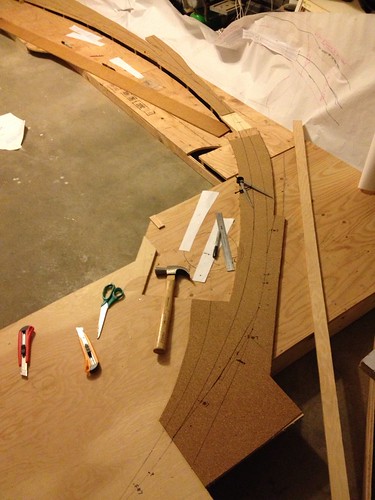My daughter's first recognizable picture was an apple. She was perhaps three, and at the time she was already a prolific artist, producing mostly pages of coloured straight, parallel lines. But this day, I was working on the endless basement reno, and she came down and presented me with a beautiful red apple with a green leaf. "Oh, what a wonderful apple!" I exclaimed. She beamed and went upstairs to produce more, reappearing a few minutes later with a sheet of parallel lines. "Lovely!" I exclaimed, "What is it?" She looked at me with the look that I hadn't expected her to perfect for at least another ten years, the look that says "Oh, Daddy, you are so dense!" and she explained, "It's lines."
What did Andrew and I (the other member of the posse being in Nevada) get up to last night?
Lines.
Two roughly parallel lines.

After sketching and doodling, mostly on scraps of paper and a good deal in my mind, I had produced the original track plan by laying out big rolls of paper on the floor and crawling about with tape measures, rulers and turnout templates while fending off the hamster in the hamster ball as she did her best to disrupt the drafting by rolling all over it and knocking papers around.
The result was a largely notional track plan, which is getting increasingly beat up as we unroll and re-roll 12 feet of paper every time we want to consult it. I have an idea where all the points and frogs go, but what exactly happens in between was left ambiguous. Last night it was time to commit the actual center lines for those tracks.
We laid out a smooth mainline with the help of an eight foot strip of Masonite and quite a few hands, clamps and nails. The mainline curve is actually smoother than the real thing; I guess William Russell didn't have a 700 foot piece of Masonite strip to help set the real center line back in 1898, and if he had, it would have taken some very big clamps and pins to keep it in position while he wielded the giant Sharpie.
The mainline was simple to lay out and we could get the locations of the frogs and points from the plan, but what about the diverging routes for the turnouts? Now, if all the turnouts were straight, it would have been a doddle, but just about all of them are curved, as you'd expect on a smallish layout. So, while the templates were sufficient for the plan, they needed to adapt to real life.
Fortunately, the templates from Proto:87 Stores include the lines that show where the straight route intersects with a straight line through the diverging route. So, our process was to place the intersection of these two lines on the mainline, and rotate it until the straight route was lined up with the curve. Then we marked where the diverging route was, and drew a straight line between the intersection point and the end of the diverging route. While we were at it, we also marked the location of the points and the frog, so the geometry should all work out at least as well as William Russell would have done.
All the turnouts are #7. I had originally planned for some #8, but the #7s look almost as good, and they enabled me to get slightly longer sidings and to put Alfred Street on plain track, rather than having the closure of the turnout on the grade crossing. We created a small piece of wood with two centerlines marked on it to locate the parallel routes from the adjacent main line, and smoothed the joining tracks with the Masonite strip. We're now ready for ties.

Rene Gourley
Modelling Pembroke, Ontario in Proto:87
Read my MRH blog
Read my Wordpress blog